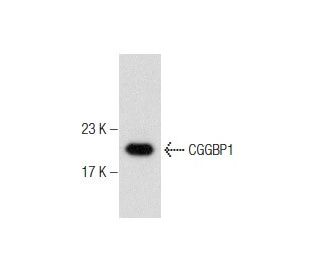


CCRF-CEM nuclear extract: sc-2146
- supplied in four vials, each containing 250 µg nuclear extract in 50 µl buffer
- provided in 20 mM HEPES (pH 7.9), 20% v/v glycerol, 0.1 M KCI, 0.2 mM EDTA, 0.5 mM PMSF and 0.5 mM DTT
- human nuclear extract; leukemic lymphoblast cells
- suitable for use in Gel Shift and Western Blotting assays
- Extracts should be stored at -70°C and repeated freezing and thawing should be avoided.
- prepared by the method of Dignam et al., (1983) Nucleic Acids Res. 11: 1475
QUICK LINKS
SEE ALSO...
The CCRF-CEM nuclear extract is derived from the CCRF-CEM cell line, which is a human T-lymphoblastoid cell line originally isolated from a patient with acute lymphoblastic leukemia (ALL). This cell line is extensively utilized in research related to hematological malignancies and cellular immunology. The nuclear extract from CCRF-CEM cells contains a broad spectrum of nuclear proteins, including transcription factors, chromatin remodeling proteins, and other regulatory molecules that play crucial roles in gene expression and cellular response mechanisms. In research, the CCRF-CEM nuclear extract is particularly valuable for studying the regulation of gene expression in T-cells, mechanisms of leukemogenesis, and the cellular response to various external stimuli that can affect T-cell behavior. Scientists employ this extract to investigate the nuclear processes that underpin T-cell development and transformation, which are critical for understanding the pathogenesis of leukemia. By examining these nuclear components, researchers can uncover how alterations in transcriptional regulation and chromatin structure contribute to the development and progression of T-cell malignancies. Insights gained from these studies provide a deeper understanding of T-cell biology and the molecular basis of their involvement in leukemia, aiding in the exploration of fundamental processes in cellular and molecular biology.
CCRF-CEM nuclear extract References:
- Etoposide-induced DNA strand breaks in relation to p-glycoprotein and topoisomerase II protein expression in leukaemic cells from patients with AML and CLL. | Zhou, R., et al. 1999. Br J Haematol. 105: 420-7. PMID: 10233413
- Human RNase H-mediated RNA cleavage from DNA-RNA duplexes is inhibited by 6-deoxythioguanosine incorporation into DNA. | Krynetskaia, NF., et al. 1999. Mol Pharmacol. 56: 841-8. PMID: 10496969
- Effect of phosphorothioate modifications on the ability of GTn oligodeoxynucleotides to specifically recognize single-stranded DNA-binding proteins and to affect human cancer cellular growth. | Morassutti, C., et al. 1999. Biochimie. 81: 1115-22. PMID: 10607406
- The role of AP-1 in glucocorticoid resistance in leukaemia. | Bailey, S., et al. 2001. Leukemia. 15: 391-7. PMID: 11237062
- Identification of different isoforms of eEF1A in the nuclear fraction of human T-lymphoblastic cancer cell line specifically binding to aptameric cytotoxic GT oligomers. | Dapas, B., et al. 2003. Eur J Biochem. 270: 3251-62. PMID: 12869201
- Analysis of folylpoly-gamma-glutamate synthetase gene expression in human B-precursor ALL and T-lineage ALL cells. | Leclerc, GJ., et al. 2006. BMC Cancer. 6: 132. PMID: 16707018
- Contribution of the orphan nuclear receptor Nur77 to the apoptotic action of IGFBP-3. | Lee, KW., et al. 2007. Carcinogenesis. 28: 1653-8. PMID: 17434920
- Histone deacetylase inhibitors induce FPGS mRNA expression and intracellular accumulation of long-chain methotrexate polyglutamates in childhood acute lymphoblastic leukemia: implications for combination therapy. | Leclerc, GJ., et al. 2010. Leukemia. 24: 552-62. PMID: 20072153
- Nucleolar proteins with altered expression in leukemic cell lines. | Teittinen, KJ., et al. 2012. Leuk Res. 36: 232-6. PMID: 21783252
- Proteomic and bioinformatic analysis of mammalian SWI/SNF complexes identifies extensive roles in human malignancy. | Kadoch, C., et al. 2013. Nat Genet. 45: 592-601. PMID: 23644491
- Protein oxidation and DNA repair inhibition by 6-thioguanine and UVA radiation. | Gueranger, Q., et al. 2014. J Invest Dermatol. 134: 1408-1417. PMID: 24284422
- DNA repair inhibition by UVA photoactivated fluoroquinolones and vemurafenib. | Peacock, M., et al. 2014. Nucleic Acids Res. 42: 13714-22. PMID: 25414333
- Identification of a 59 bp enhancer located at the first exon/intron boundary of the human O6-methylguanine DNA methyltransferase gene. | Harris, LC., et al. 1994. Nucleic Acids Res. 22: 4614-9. PMID: 7984409
Ordering Information
| Product Name | Catalog # | UNIT | Price | Qty | FAVORITES | |
CCRF-CEM nuclear extract | sc-2146 | 250 µg/0.05 ml | $160.00 |
